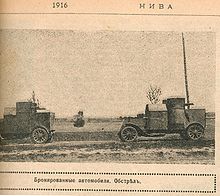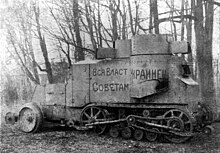|
Austin armoured car
The Austin armoured car was a British armoured car produced during the First World War. The vehicle is best known for its employment by the Imperial Russian Army in the First World War and by different forces in the Russian Civil War. In addition to the British-built Austins, a few dozens of vehicles were manufactured in Russia in 1918–20. These are usually referred to as Austin-Putilov or – if fitted with a Kégresse halftrack chassis – Austin-Kégresse. Production historyBritish Austins In August 1914, just after the beginning of the First World War, the army of the Russian Empire started to form armoured car units. Due to limited production capabilities of the country's automotive industry it was decided to order a number of vehicles abroad. A committee was sent to the United Kingdom, but failed to find an armoured car that met their requirements for overhead protection and two machine gun turrets. To meet these requirements, the Austin Motor Company designed a new armoured car. The vehicle, known as Austin 1st series, was based on a passenger car chassis with rear-axle drive. Wheels were wooden, spoked, with pneumatic tyres and an additional set of wheels with full rubber tyres for use in combat was carried. Two Maxim machine guns were mounted in separate turrets placed on both sides of the hull behind the driver's cab. The vehicle was protected by armour plates 3.5–4 mm thick screwed to a body frame. The crew of four – commander, driver and two gunners – could enter or leave the vehicle via a door on the left side of the cab or via big two-leaf rear door. On 29 September 1914, 48 armoured cars were ordered. One car cost 1,150 pounds. After arrival in Russia the front and turret armour was replaced with 7 mm plates. First combat experience, however, revealed that the protection was still too weak and the vehicles were fully rearmoured at Izhorski Works, Izhorsk. The improved armour made the Austins much heavier, resulting in limited mobility and occasionally in chassis damage. However, the car was still considered more successful than alternative designs by, among others, Armstrong Whitworth, Renault and Sheffield-Simplex. On 6 March 1915 the Russians ordered 60 vehicles of an improved design, known as Austin 2nd series. This time the chassis of a 1.5 ton truck with a more powerful engine was used. The hull was shorter, with thicker armour, the driver's cab roof was modified to improve machine guns' angle of fire. Less welcome was a removal of rear access door. The army also decided it wanted a rear driving post, so after arrival to Russia all vehicles were fitted with a redesigned rear hull section, which housed a second driving post and additional hatch. Another upgrade was the addition of side shields to the machine guns. Sixty units of Austin 3rd series were ordered on 25 August 1916. The vehicles were similar in characteristics to the 2nd series, but had modified rear hull with driving post, MG shields, bulletproof glass in the front vision slots and lacked big side windows. Yet another version, with strengthened chassis and double rear wheels, sometimes referred to as Austin model 1918, was ordered in 1917 but due to events in Russia none were delivered. Russian Austins In 1916 a decision was made to produce a Russian armoured car on the well known Austin chassis. Sixty chassis units – identical to those used in 3rd series – were ordered from Austin. The mission of building armoured hulls was entrusted to Putilovski Works, Saint Petersburg. It was planned to build the cars by July 1917, but work was virtually brought to halt by the February Revolution and the subsequent chaos. Not until March 1918 were the first cars produced. Later the production was transferred to Izhorski Works. A total of 33 vehicles were produced in 1918–1920. In contemporary Russian documents the model was referred to as Russian Austin (Russian: Русский Остин – Russkij Ostin), but eventually became better known as Austin-Putilov (Russian: Остин-Путиловец – Ostin-Putilovets). Twelve hulls identical to those of Austin-Putilov were mounted on a Kégresse halftrack chassis, resulting in vehicles known as Austin-Kégresse. Production continued from July 1919 until March 1920 when it was stopped by shortage of materials and parts. Russian Austins' most obvious features were diagonally placed MG turrets (in order to reduce width) and additional right side door. They also had MG mounts with better elevation and other minor improvements. Service historyRussia Arrival of the 1st series Austins allowed the formation of 'automobile machine gun platoons' (Russian: пулемётный автомобильный взвод – pulemyotniy avtomobilniy vzvod or автопулемётный взвод – avtopulemyotniy vzvod). First platoons (5–12), formed according to the organization no. 19, each had three Austins, four staff cars, a truck, a workshop truck, a tanker truck and four motorcycles, with personnel of four officers and 45–46 soldiers. Further platoons (13–24, 26–28, 30–36), formed according to the organization no. 20, received only two Austins, but had a gun section consisting of a gun-armed Garford-Putilov Armoured Car, a staff car, a truck and a motorcycle. Platoons 5 to 12 received an additional Garford. Crews of those auto-MG platoons were entirely drawn from volunteers. Most of the platoons were used in the Western and South-Western Fronts, some platoons in the Northern Front and Caucasus. In combat they were attached to divisions or regiments. By mid-1916 it was evident that larger units should be formed to make armoured cars more effective. In August, platoons were arranged into twelve "armoured automobile battalions" (Russian: броневой автомобильный дивизион – bronyevoy avtomobilniy divizion or автобронедивизион – avtobronedivizion), each attached to a specific army. Each battalion was formed from two to five former platoons, which were renamed to sections whilst retaining the old number. In some cases, for example in the Caucasus theatre, the platoon organization was retained. In the Russian Civil War Austins were used by many participants, including both Red and White armies, Ukrainians etc. The Red Army had the largest number of vehicles, including all the Austin-Putilov and Austin-Kergesse vehicles and most of the 3rd series. In Soviet service the cars were organized into "armoured automobile units" (Russian: броневой автомоильный отряд – bronevoy avtomobilniy otryad or автоброневой отряд – avtobronevoy otryad), similar in strength to a World War I-era platoon: three machine gun-armed cars and one either gun-armed or machine gun-armed, four staff cars, five trucks, a tanker truck, a workshop truck and four motorcycles. The Red Army (RKKA) Austins also saw combat in the Polish-Soviet War. By 1921 the RKKA possessed about 16 Austins of the 1st series, 15 2nd series, 78 3rd series and Putilovs. British-built Austins were removed from service by 1931, and by 1933, the Russian-built ones were also retired. The Austin-Putilov armoured car named Vrag Kapitala ("Enemy of the Capital"), on display at the Artillery Museum, Saint Petersburg, is often referred to as the vehicle which Lenin stood on to address the crowd in April 1917. However, it cannot be true as this armoured car was not manufactured until 1919. Other users
Sixteen of the Austins built for Russian but not sent following the revolution were used to equip the 17th (Armoured Car) Battalion of the Tank Corps. The Vickers machine guns were exchanged for the Hotchkiss M1914 machine gun, which was the standard machine gun of the British tank unit. The 17th Battalion arrived in France in April 1918. Its first operations were in support of the French Army in June.[1] It returned to the British Army in August and was very successful at the Battle of Amiens. The Austins were towed in pairs by tanks across the mud of no-man's-land. Once they reached better ground on the other side of the lines, they ranged freely. A German Corps headquarters 10 miles back was captured and German reserves, artillery and supply lines were shot up.[2] Having crossed the German frontier at Malmedy, Belgium, on 1 December 1918 after the Armistice, the 17th was the first British unit to enter Cologne on the Rhine on the 8th, escorting the Commanding Officer of 2nd Cavalry Brigade to negotiate Allied control of the city.[3] After the war, the bodies were reused on Peerless lorry chassis. Some of these were still in service at the start of the Second World War. Some cars were sent to the Caspian Sea region. Austins were also used by the British in the Irish War of Independence. Variants
Operators 
Notes
References
External linksWikimedia Commons has media related to Austin armoured car. |
||||||||||||||||||||||||||||||||||||||||||||
